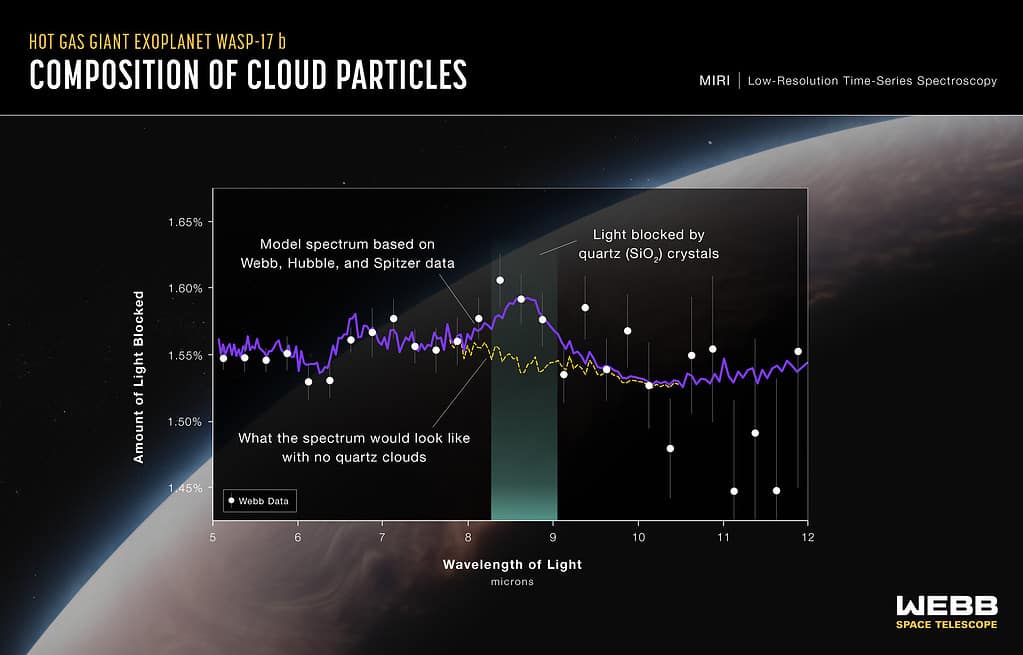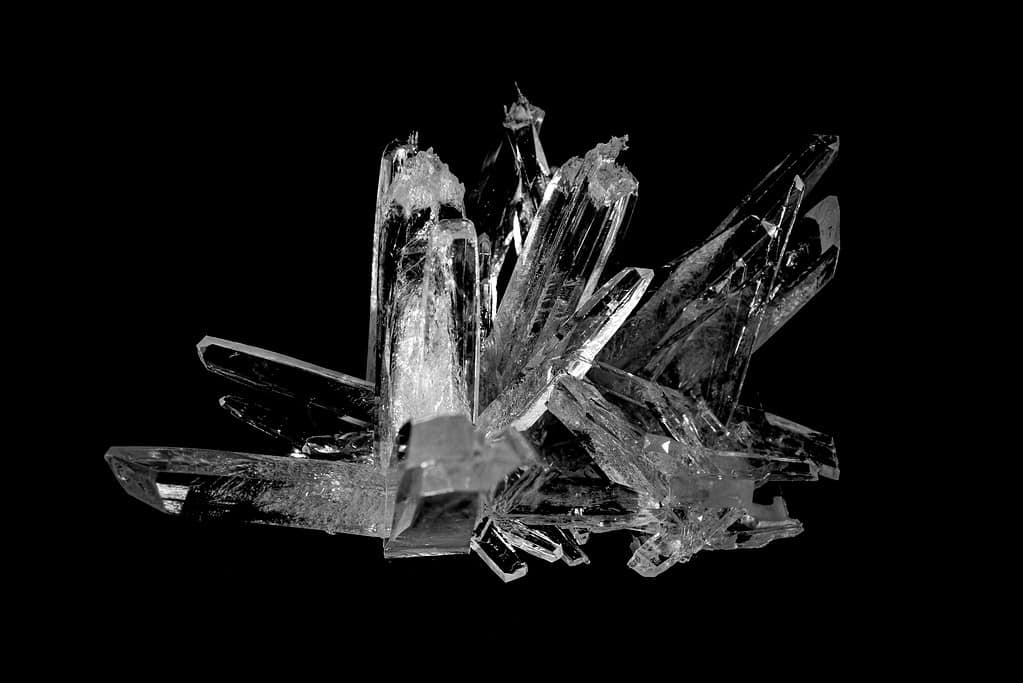
The James Webb Space Telescope has captured a transmission spectrum of the hot gas giant exoplanet WASP-17 b, revealing the first-ever evidence of quartz (SiO2) in an exoplanet’s clouds. In fact, this groundbreaking finding is the first identification of any specific cloud species in a transiting exoplanet.
“We were thrilled!” said David Grant, a researcher at the University of Bristol in the UK and first author of the new research. “We knew from Hubble observations that there must be aerosols — tiny particles making up clouds or haze — in WASP-17 b’s atmosphere, but we didn’t expect them to be made of quartz.”
Fluffy puffy hot exoplanets
WASP-17 b is about 1,000 light-years (310 parsecs) from Earth. It’s a big, hot, Jupiter-type planet with a very low density; in fact, it’s one of the “puffiest planets” ever discovered. But we can’t see it — we only know it’s there because it blocks some of the light from its star. That’s why it’s called a “transiting” exoplanet, because what we know about it, we know from when it transits in front of its star.
Yet, we know what it has in its atmosphere thanks to a new study that involved the James Webb Telescope.
Astronomers measured changes in brightness across 28 different wavelengths as the planet crosses in front of its star. By calculating the difference between the original light emitted by the star and the light that made it through the planet’s atmosphere, scientists could determine which wavelengths were absorbed by the planet’s atmosphere, thus giving clues to its composition.

The data was collected over nearly 10 hours and involved more than 1275 measurements before, during, and after the planet’s transit across its host star. For each wavelength, the amount of light blocked by the planet’s atmosphere (white circles in the chart above) was calculated by subtracting the light that made it through the atmosphere from the light emitted by the star. Different molecules correspond to different wavelengths, and in the wavelength of quartz, there was a surprising “bump”.
In other words, the presence of quartz crystals would perfectly explain the observed data.
A common mineral in an uncommon place
Quartz is a common mineral on Earth and it’s probably present in other rocky planets as well. But it’s present in the crust of the Earth — not the atmosphere. It’s not what researchers were expecting at all. Co-author Dr Hannah Wakeford, Associate Professor in Astrophysics at the University of Bristol, said:
“We fully expected to see magnesium silicates. But what we’re seeing instead are likely the building blocks of those, the tiny ‘seed’ particles needed to form the larger silicate grains we detect in cooler exoplanets and brown dwarfs.”
The quartz crystals in WASP-17 b are probably similar in shape to what you find in gem shops on Earth (pointy hexagonal prisms), but much smaller. Each one is probably around 10 nanometers across, or 10,000 times smaller than the width of a human hair.

There’s another interesting bit about the atmospheric crystals. Quartz is a mineral comprising silicon and oxygen. But it’s not the only silicate mineral. In fact, when astronomers discover signs of silicate crystals on exoplanets, it’s usually other silicate minerals (like olivine and pyroxene), not pure quartz. Researchers suspect the planet’s peculiarities can account for this.
“WASP-17 b is extremely hot — around 1,500 degrees Celsius (2,700°F) — and the pressure where they form high in the atmosphere is only about one-thousandth of what we experience on Earth’s surface,” explained Grant. “In these conditions, solid crystals can form directly from gas, without going through a liquid phase first.”
But the quartz crystals aren’t the only thing that makes WASP-17 b unique.
A strange, hellish planet
WASP-17 b is weird for a few reasons. It’s not uncommon that it’s a “Hot Jupiter” but it is uncommon because of the way it spins. It rotates in a direction counter to its orbit of the star. When it was discovered in 2009, it was the only planet known to do so. In fact, the discovery was so surprising that it challenged traditional planetary formation theory.
But the planet itself is tidally locked — meaning it only “sees” its star on one side, much like we on Earth only see one side of the moon. This means that one side is much hotter than the other. This creates massive winds that can move the particles around at high speeds.
“The clouds are likely present along the day/night transition, which is the region that our observations probe,” said Grant. “The winds could be moving these tiny glassy particles around at thousands of miles per hour.”
The study is also a nod to the Hubble Telescope. Although the chemical signature of the crystals was only possible thanks to the tools onboard the James Webb Space Telescope, Hubble also played its part.
“Hubble data actually played a key role in constraining the size of these particles,” explained co-author Nikole Lewis of Cornell University, who leads the Webb Guaranteed Time Observation (GTO) program designed to help build a three-dimensional view of a hot Jupiter atmosphere. “We know there is silica from Webb’s data alone, but we needed the visible and near-infrared observations from Hubble for context, to figure out how large the crystals are.”
Exactly how much quartz is on the planet and what this means for other exoplanets is hard to figure out. But the revelation of quartz in the atmosphere of WASP-17 b isn’t just a single “Eureka” moment for planetary scientists, it’s a turning point. With James Webb, we can explore the atmosphere of exoplanets in unprecedented detail. As our tools get more sophisticated, so too does our view into the universe’s complexities.
The James Webb Space Telescope, still in its early days of operational life, is already redefining the frontiers of what we know about exoplanets. This study showcases how much it can accomplish, especially when paired with other telescopes like Hubble.
The study “JWST-TST DREAMS: Quartz Clouds in the Atmosphere of WASP-17b” was published in the journal Astrophysical Journal Letters.






